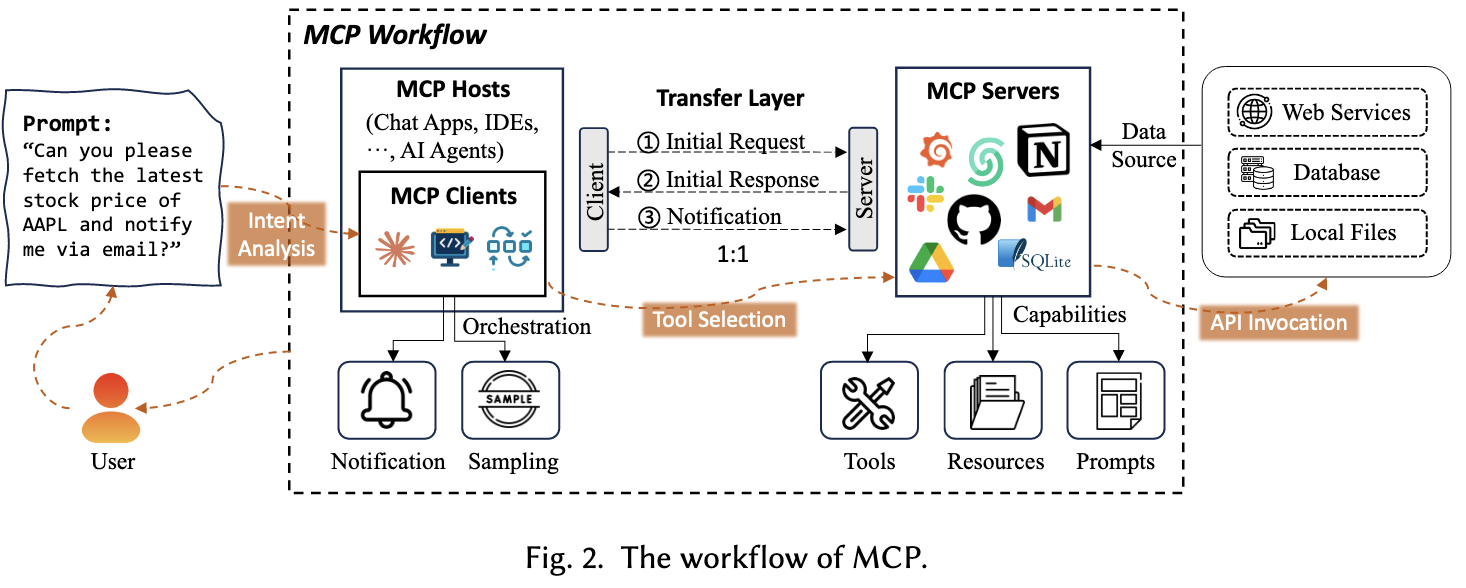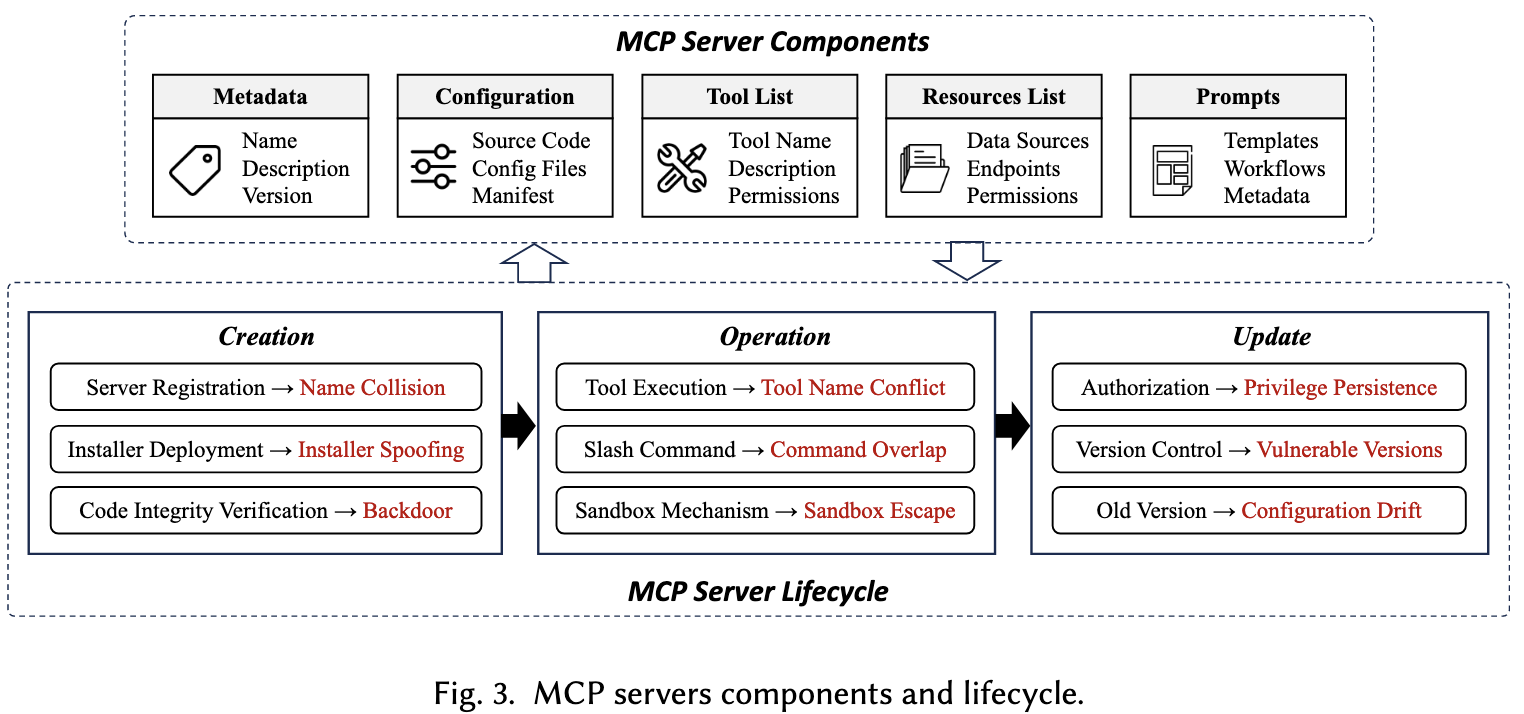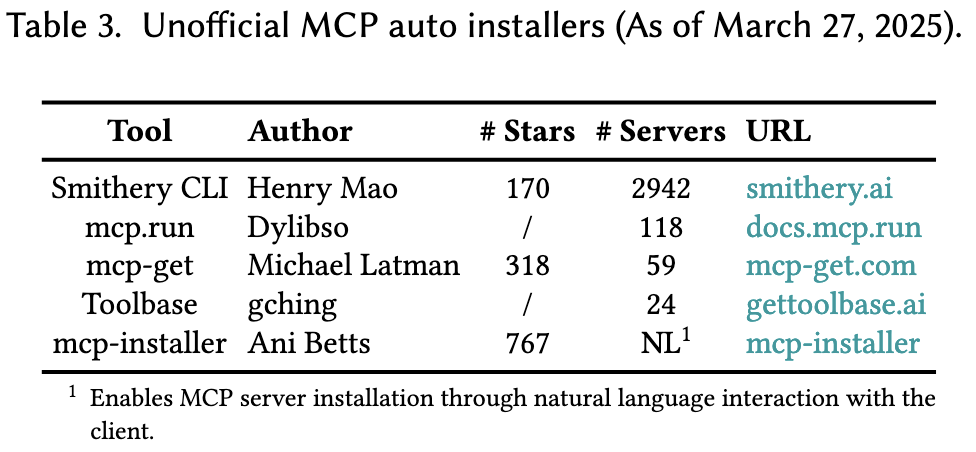Model Context Protocol (MCP): Landscape, Security Threats, and Future Research Directions
Update: April 29, 2025
Model Context Protocol (MCP): Landscape, Security Threats, and Future Research Directions
对MCP的架构及现有应用情况进行介绍,并分析其潜在安全问题,指出未来研究方向。
Background
Limitation of current AI tools
- Manual API Wiring: required custom authentication, data transformation, and error handling for every integration
- Standardized Plugin Interfaces: (1) one-directional and could not maintain state or coordinate multiple steps in a task, (2) platform-specific
- AI Agent Tool Integration (e.g., LangChain): largely manual, requiring custom implementations
- Retrieval-Augmented Generation (RAG): limited to passive retrieval of information, cannot update data or trigger workflows.
MCP Architecture
Core Components

-
MCP Hosts: AI application that provides the environment for executing AI-based tasks while running the MCP client.
-
MCP Client:
- processes notifications from MCP servers
- performs sampling to gather data
-
MCP Server: managing external tools, sources, and prompts
- Tools: Enabling external operations
- Resources: Exposing data to AI models
- Prompts: Reusable templates for workflow optimization
-
Transfer Layer
- initial request: query the server’s functionalities
- initial response: listing the available tools, resources, and prompts
- exchange of notifications
MCP Server Lifecycle & Security Threats

Creation Phase
-
Name Collision
- malicious server can register a similar name to legitimate server
- %% 恶意实体通过注册与合法MCP Server相似或相同的名称,欺骗用户安装恶意Server。 %%
-
Installer Spoofing
- unofficial auto-installers install unverified malware
- %% 来自非官方渠道的自动安装工具可能会安装未经验证的软件包 %%
-
Code Injection / Backdoor
- malicious code embedded into the MCP server’s codebase
Operation Phase
-
Tool Name Conflicts
- malicious tool can register a similar name to legitimate tool
-
Slash Command Overlap
- multiple tools can register similar commands (e.g., /delete: A. remove temporary, B. erase critical system logs)
-
Sandbox Escape
- break out of the restricted environment and gain unauthorized access to the host system
Update Phase
-
Post-Update Privilege Persistence
- outdated privileges remain active after an MCP server update (e.g., API key)
-
Re-deployment of Vulnerable Versions
-
Configuration Drift
- manual adjustments, overlooked updates, or conflicting modifications made
- unintended changes accumulate in the system configuration
MCP Current Landscape


Future Directions
Challenges
- Lack of centralized security oversight
- Authentication and authorization gaps
- Insufficient debugging and monitoring mechanisms
- Maintaining consistency in multi-step, cross-system workflows
- Scalability challenges in multi-tenant environments: consistent performance, security, and tenant isolation
- Challenges in embedding MCP in smart environments: real-time responsiveness, interoperability, and security
Suggestions
-
MCP maintainers
- establish a formal package management system
- centralized server registry
- implementing a secure sandboxing framework
-
developers
- adhering to secure coding practices and maintaining thorough documentation
- automate configuration management to mitigate configuration drift
-
researchers
- version control and package management in decentralized ecosystems
- sandbox security, mitigate privilege persistence, prevent configuration drift
- context-aware agent orchestration in multi-tool environments %% ensuring state consistency and preventing tool invocation conflicts %%
-
end-users
- using verified MCP servers
- regularly updating MCP servers and monitoring configuration changes